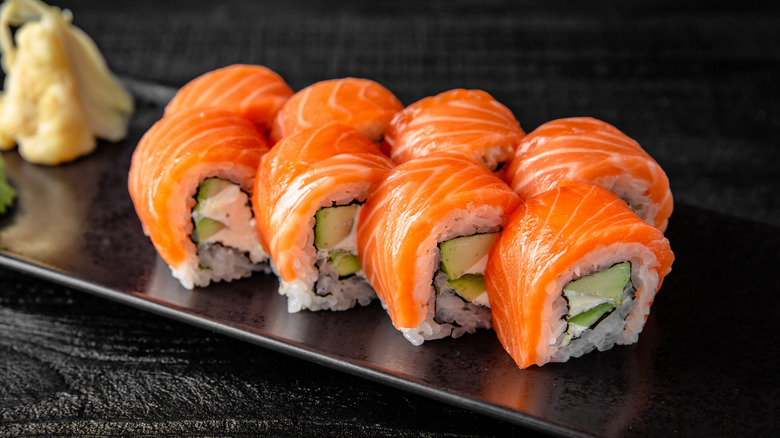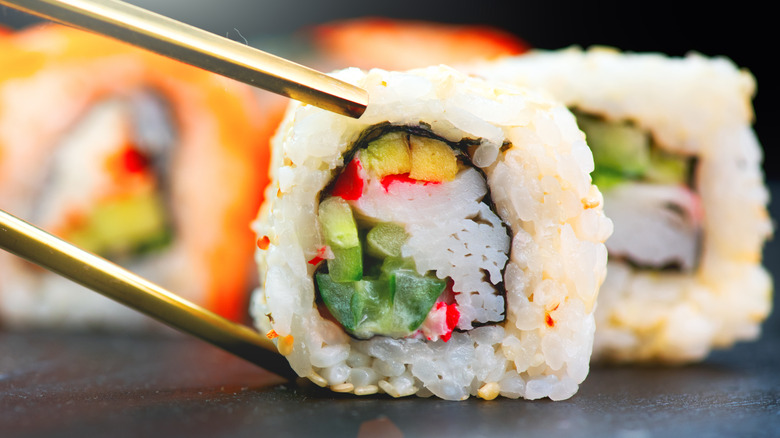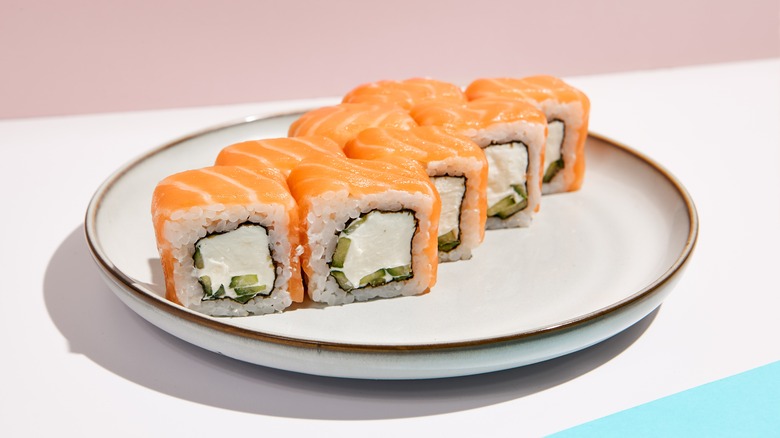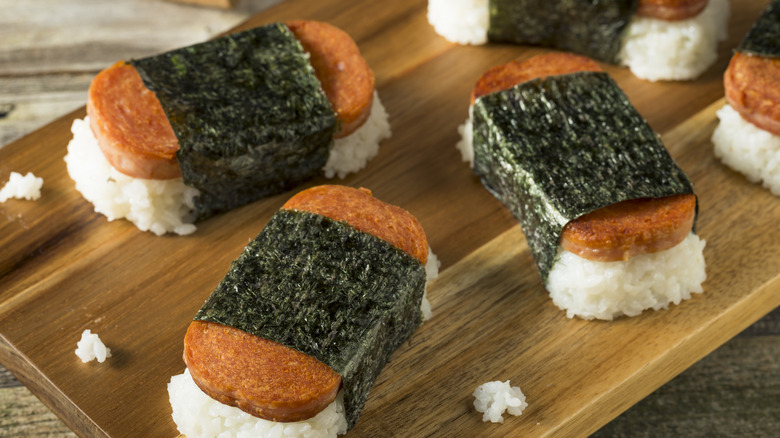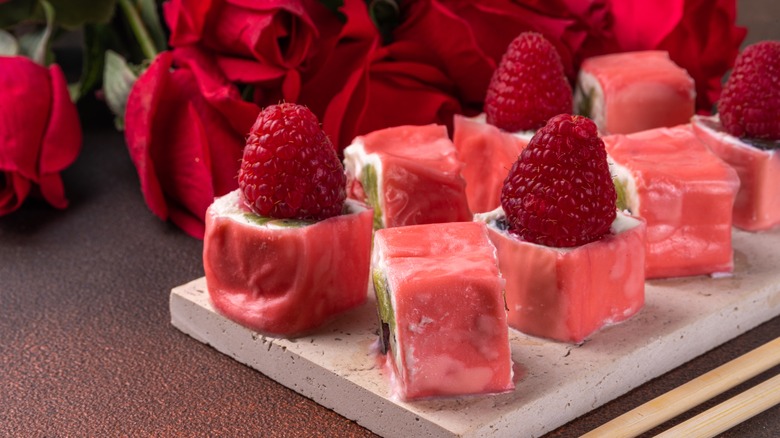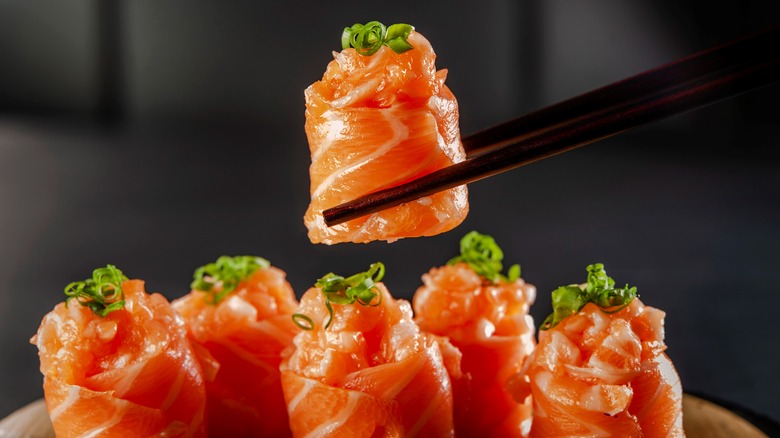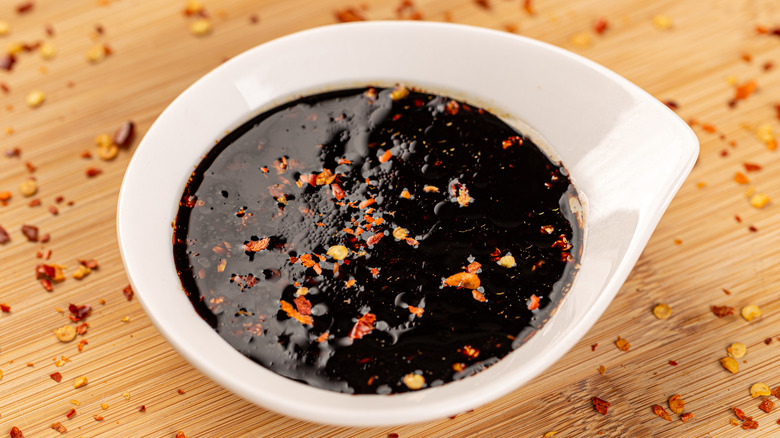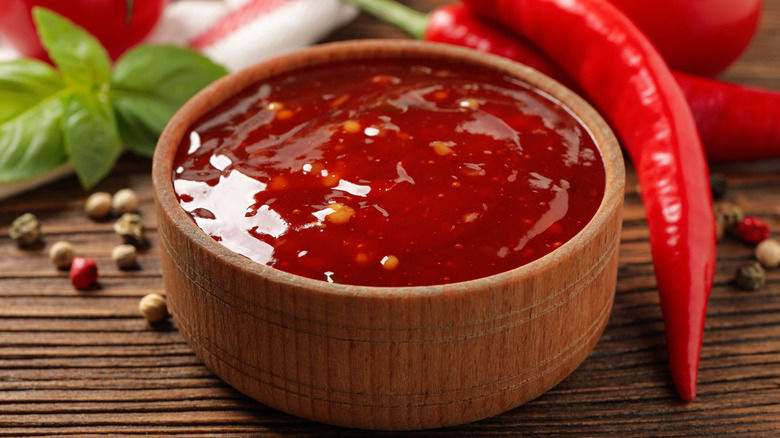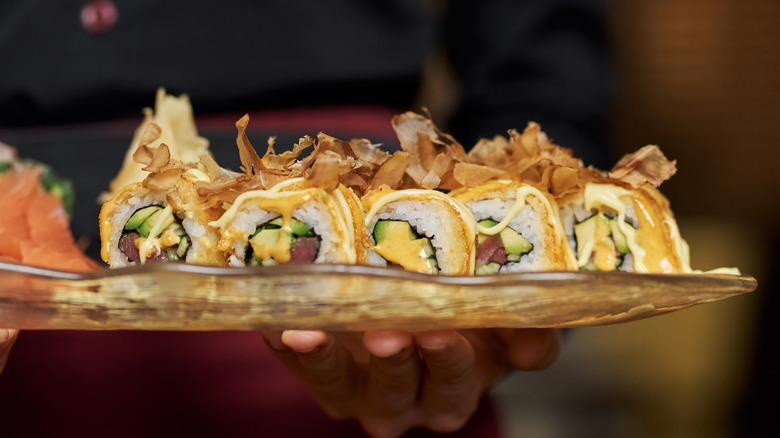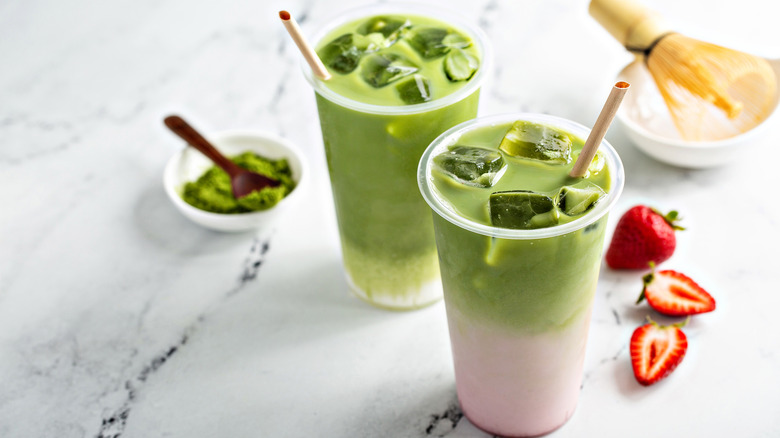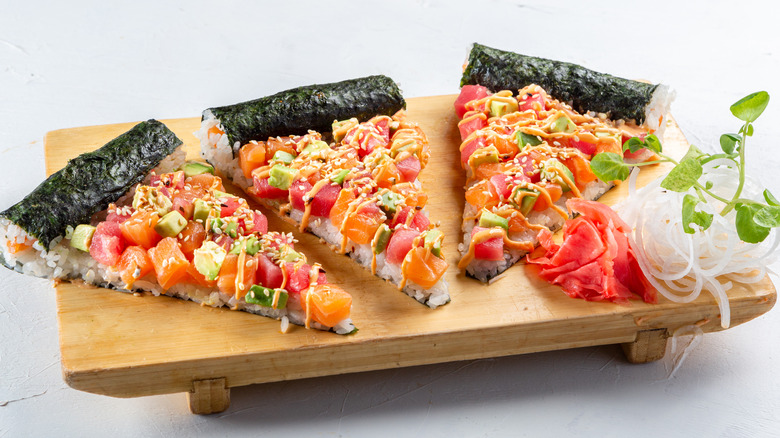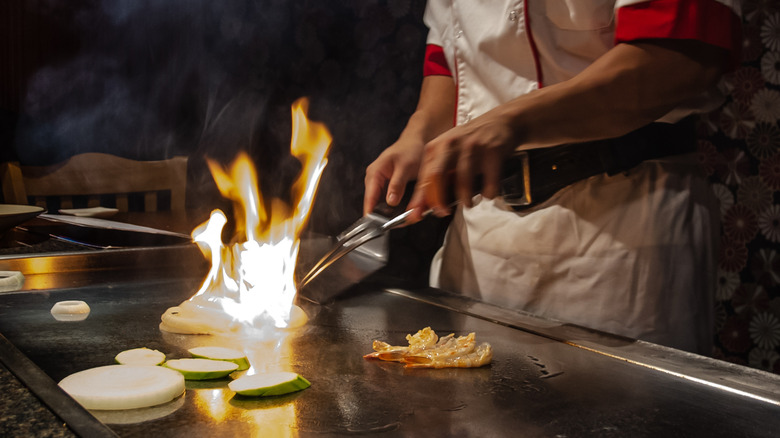11 Things You Probably Shouldn't Order At Japanese Restaurants
These days, it seems that consumers are more obsessed with finding authentic foreign eats than ever before — and there are numbers to back this up. According to Technomic's 2018 Ethnic Food & Beverage Consumer Trend Report (via Food Dive), 87% of American consumers say they enjoy foreign foods. Of that 87%, almost half report always preferring authentic versions of foreign food over Americanized alternatives. In fact, 32% of consumers were so invested in finding the "real" versions of foreign foods that they reported a willingness to pay more money to guarantee that their dinners were actually authentic.
Although consumers are excited to try real international eats, it is difficult to define what makes food "authentic," as most cultures have shared, fused, and adapted their culinary methods over time. When it comes to Japanese cuisine, for example, some longtime cooking methods, like tempura, didn't originate in Japan. As explained by the BBC, tempura came to Japan in the 16th century via the Portuguese, who shared their recipe for fried battered green beans. Because of this, the Japanese word "tempura" probably originates from the Portuguese word "tempero," meaning "seasoning" (via Online Etymology Dictionary).
While pinpointing food authenticity is challenging, many so-called "Japanese" foods were not invented, or even adapted, in Japan. On the contrary, much of contemporary Japanese restaurant fare was actually developed in North America. If you're hoping to try authentic Japanese food — or at least avoid Americanized Japanese food — here are some items to skip.
1. California rolls
If you are interested in going to a Japanese restaurant, you might be tempted to order a California roll. After all, for some Westerners, this delicious combination of avocado, cucumber, and imitation crab might seem more familiar. For one thing, California rolls lack raw fish, which many aren't used to eating on a regular basis. And, for another, this roll hides the seaweed element beneath a thick layer of white rice. Unfortunately, however, this is sort of the point.
The California roll's history reveals that it's far from being authentic. According to the Encyclopedia Britannica, this roll was invented in Los Angeles in the 1960s by Japanese chef Ichiro Mashita. While working at the restaurant Tokyo Kaikan, Mashita noticed that many Americans were hesitant to enjoy traditional Japanese sushi. As a way to appease these restaurant-goers, Mashita invented a "Westernized" sushi roll that replaced raw tuna with ingredients that American clients found more familiar: avocado and crab. He also inverted the roll, placing the seaweed on the inside and the rice on the outside.
Interestingly, Mashita was not the only chef who inverted his sushi rolls to draw North American clients. In Vancouver during the 1970s, chef Hidekazu Tojo dreamed up his own version of the California roll, using Dungeness crab, eggs, spinach, and avocados, according to Insider. As the chef told the outlet in an interview, Canadians at the time were "afraid" to try seaweed. Consequently, Tojo said, "I did it inside out."
2. Philadelphia rolls
Like California rolls, Philadelphia rolls were invented in the United States. And, although they are delicious, Philadelphia rolls aren't stuffed with typical Japanese ingredients, like raw fish. Instead, they are generally filled with elements that Americans enjoy — principally cream cheese, cucumbers, and smoked salmon (via This Japanese Life). With this in mind, foodies on the hunt for authentic food should probably avoid ordering Philly rolls at a Japanese restaurant.
According to a report by WPVI-TV Philadelphia, Philly rolls first came to fruition in the 1980s when a Japanese chef named Madame Saito opened a restaurant in Philadelphia. Just like many Japanese chefs before her, Saito found that most Americans were not particularly open to trying sushi. "Philadelphia didn't know anything about sushi when I came from Tokyo to this country," Saito recalled. As a result, the chef — or the "Queen of Sushi" as Philadelphians like to call her — decided to create a roll that incorporated more local flavors. "I do reverse roll — the rice outside, inside with the smoked salmon and cream cheese ... Because a lot of people by that time, that's years ago, they still didn't want to eat raw fish," she revealed.
Although Philadelphia rolls aren't typical in Japan, Madame Saito says that Japanese chefs haven't shunned her invention. As she told the South China Morning Post in an interview, "Whenever I bring my new ideas back to Japan, local sushi chefs ask me about my creations — they're curious."
3. Spam musubi
While certainly flavorful, Spam musubi is not the ideal item to order at a Japanese restaurant because, like California and Philadelphia rolls, Spam musubi hails from the United States. According to "The Musubi Book" by Manabu Asaoka (via Forbes), this meal likely emerged in the 1980s when Japanese-American nutritionist Barbara Funamura started to prepare a unique combination of Spam and white rice, wrapped in nori. Funamura, who was born and raised in Hawaii, sold her creation locally at an old restaurant called Joni-Hana. Her invention quickly became a beloved Hawaii classic.
Although it probably wasn't invented until the 1980s, Spam musubi boasts WWII roots. During this time of turbulence, the United States government fed Spam to its troops, who touted the canned meat's merits wherever they went (via Smithsonian Magazine). Since there was a large military base at Pearl Harbor, Spam quickly became desired among Hawaiians. To this day, Spam remains popular in Hawaii. Per "The Musubi Book" (via Forbes), Barbara Funamura's unique musubi recipe partially owes its popularity to Hawaiians' love for Spam.
When it comes to searching for authentic Japanese food on a restaurant menu, Spam musubi is not exactly a winner. Nonetheless, this delightful meal is an inexpensive and easy option for home cooks to experiment with on their own. This Spam musubi recipe only calls for six ingredients, making it the perfect thing to make on a busy weeknight.
4. Raspberry cheesecake rolls
At the end of your sushi dinner, you might find yourself craving a raspberry cheesecake sushi roll. Indeed, this tantalizing combination of cream cheese, raspberry sauce, and bits of fruit can be a delicious way to wrap up a meal. However, if you're in the market for a traditional Japanese dessert roll, stay away from cream cheese sushi — or anything involving any kind of cheese at all. The reason for this is that cheese is not a common ingredient in Japanese cuisine (via Japan Truly). In fact, very few Japanese people consume cheese on a regular basis. A 2017 survey by the Mitsubishi Research Institute found that only 6% of Japanese people eat cheese every day (via Statista). As a result, if you're eyeing a Japanese restaurant menu and wondering which foods aren't authentic, you can quickly count out anything smothered in queso.
Just because raspberry cheesecake rolls aren't authentically Japanese, however, doesn't mean that you can't enjoy a real Japanese dessert. One summertime favorite, known as kakigori, is a type of snow cone topped with condensed milk, fruit, and other sweet syrups. Foodies who care a lot about authenticity will be relieved to know that this treat has been popular with the Japanese aristocracy since at least as far back as the 11th century. As per Inside Japan, members of the elite would enjoy servings of shaved ice sweetened with amazura, which is described as being made from a vine.
5. Salmon sushi
Raw salmon has become something of a key ingredient at sushi restaurants. Thanks to foodie favorites like salmon maki, salmon temaki, and salmon nigiri, this fatty fish is all over most Japanese restaurant menus. Interestingly, however, salmon sushi is far from being a Japanese classic. On the contrary, for many years, the Japanese avoided eating raw salmon. As explained by Sweetish Hill, the reason for this pertains to the parasites that can live in Pacific salmon. Fearing foodborne illnesses, people in Japan ate sushi sans raw salmon for generations.
According to a piece in NPR, this dynamic finally started to change in the 1980s when Norway found itself facing a national salmon excess. In hopes of selling the extra fish, the Norwegian government hired Bjorn Eirik Olsen to go to Japan and convince people to start incorporating salmon into sushi. However, this plan was initially met with resistance. As Olsen recalled to NPR, "And they say, '[I]t's impossible. We Japanese do not eat salmon roll[s].' They say, '[I]t doesn't taste good.' They say, '[T]he color is wrong also; it should be redder. It has a smell.'" Ultimately, Olsen sold Norway's salmon to Nishi Rei, a frozen food company that agreed to sell salmon sushi in grocery stores. Thus, the winning combination was born.
Because of this fascinating history, however, salmon sushi cannot be considered authentic Japanese food but rather Japanese-Norwegian fusion. Food purists who want traditional eats should avoid it, although it certainly is delicious.
6. Teriyaki sauce
According to the Food Republic, teriyaki sauce consists of four major ingredients: soy sauce, ginger, sake, and sugar. The result is a sweet yet salty flavor that pairs well with everything from fish to vegetarian fare, such as these grilled teriyaki mango skewers. Although this sauce is widely available in Japanese restaurants, it should be avoided by anyone who wants to stick to authentic Japanese foods. The reason is that, like Spam musubi, teriyaki sauce didn't originate in Japan but rather in the United States.
As noted by Char'd Southeast Asian Kitchen, teriyaki sauce was invented in Hawaii after a wave of Japanese immigrants came to the islands in the 1960s. Many of these people got creative with the unique ingredients available in Hawaii and began mixing soy sauce with pineapple juice to make a marinade. Eventually, this sweetened soy sauce caught on, although its ingredients were modified a bit to fit the palate of the American consumer. The final result was the teriyaki dipping sauce that so many foodies love today.
While teriyaki sauce isn't a Japanese creation, the same cannot be said for the teriyaki culinary method. In Japanese, the word "teriyaki" means "glossy broil" and is used to describe a cooking style where food is glazed in soy sauce and grilled (per Encyclopedia Britannica). This way of preparing meat is very traditional in Japan, meaning that folks on the lookout for authentic eats should consider ordering some delicious teriyaki salmon.
7. Anything with tons of sauce
Teriyaki sauce is not the only condiment to avoid at a Japanese restaurant. The reality is that no authentic Japanese food will ever be served with excessive sauces of any kind. As noted by Laughing Squid, Japanese folks don't share the Western passion for sushi covered in sauces. On the contrary, in the Japanese view, the best part of sushi is essentially the meal's simplicity. As chef Jun Yoshizuki told the outlet, veritable Japanese sushi focuses on "enjoying the pure flavor of ingredients that are in season." Consequently, Yoshizuki says, "Japanese sushi finishes with a little bit of soy sauce." For him, this is a huge contrast with the American style of "using [a] bunch of other sauces and spices [in sushi recipes]."
One of the biggest examples of this phenomenon is the American tendency to mix wasabi in soy sauce. In an interview with First We Feast, Trevor Corson, the author of the book "The Story of Sushi," explained that the Japanese find this American tradition counterintuitive. Corson told the outlet, "[I]mmersed in a water-based liquid such as soy sauce, [wasabi] loses its spiciness. From a culinary point of view, you're counteracting the very purpose of wasabi by putting it in soy sauce." Likewise, folks who use a lot of wasabi are unknowingly signaling the chef to serve them, as Corson put it, "stuff they're trying to get rid of since the customer will not be able to taste the difference."
8. Any sushi with lots of toppings
Similar to sauces, sushi toppings are not common in Japan. Whereas Americans enjoy their rolls topped with anything from fried crab legs to eel sauce, the Japanese prefer their sushi to tend toward simpler flavors (via It's Japanese). As Los Angeles-based chef Brandon Hayato Go told the Michelin Guide, "There is a wide range of personal tastes for consumers in both countries, but in general, I think Japanese consumers value simplicity and purity in sushi, whereas American consumers are more interested in seeing a novel approach to sushi with different sauces, cooked or seared fish, and non-traditional toppings."
Compellingly, the reason that Japanese people prefer simpler sushi is that they want to enjoy the distinct flavors of the fish, rice, and seaweed in each roll. In fact, savoring these elements is so important in Japanese culture that restaurant-goers often ask the sushi chef to tell them which option has the freshest ingredients on a given day. As sushi expert Trevor Corson told First We Feast in an interview, "When people in Japan eat sushi — which is far less than Americans at this point — it's at a bar, where the expectation is that there's a chef that's going to interact with them and suggest the things that are in season." Because of this cultural divide, people searching for authentic Japanese food should order simple sushi rolls at a restaurant with fresh fish.
9. Matcha with sugar
According to Moya, matcha is a type of green tea that was originally consumed in China. It has a soft flavor and a similar caffeine content to coffee, making it an enjoyable way of upping your energy levels. The beverage first appeared in Japan during the 12th century when a Buddhist monk named Myoan Eisai found that consuming matcha facilitated his meditations. Soon, matcha became a major part of the local culture, even inspiring the traditional Japanese tea ceremony or "chado."
These days, matcha can be found in bars and eateries all across the world, with matcha tea lattés available anywhere from boutique creameries, like Miami's Dasher & Crank, to chain cafés like Starbucks. Since it's not uncommon for Westerners to add sugar to their coffee or tea, many versions of Westernized matcha contain sugar as well. Unfortunately, this isn't authentic. As explained by Easy Homemade Sushi, the Japanese do not add sugar to their matcha. Instead, when sipping tea, they prefer to enjoy the hot liquid's pure flavors. To prepare matcha the Japanese way, prepare it in water that isn't quite boiling, as this will prevent the tea from developing a harsher taste.
If you're interested in consuming authentic Japanese fare, you shouldn't add sugar to your matcha. However, that doesn't mean that you should avoid matcha-flavored desserts, as these are actually common in Japan. To experience a Tokyo-inspired sweet, eat matcha pancakes or even matcha tiramisu (via JW).
10. Sushi pizza
It's not necessarily mind-blowing to think that sushi pizza is not from Japan — after all, most foodies know that pizza is an Italian classic. However, sushi pizza is not necessarily an Italian invention. If you do ever want to try the original sushi pizza, you won't find it at a Japanese restaurant. Instead, you'll either have to head either to a Canadian or Brazilian-style eatery to get a taste of this unique food.
According to Gordon Ramsay Recipes, one of the first iterations of sushi pizza was created in the 1990s by chef Kaoru Ohsada in Toronto. Ohsada's creation essentially consisted of a sushi roll, made with the typical combination of rice and nori, that was served in the shape of a piping hot slice. This Canadian treat takes a typical Westernized sushi recipe and presents it in an Italian format.
While the Canadian version of sushi pizza is interesting, the Brazilian take on this so-called "Japanese-Italian" fusion is completely different. As reported by Brazilian outlet Veja São Paulo, some restaurants in the nation of Pelé serve traditional mozzarella pizza with pieces of sushi stacked on top. Interestingly, this is hardly the only way that Brazilian chefs have adapted Japanese food to appeal to locals. According to Nossa Uol, over the years, items born of Brazilian-Japanese fusion have included dessert sushis stuffed with regional ingredients like açaí, guava paste, and cheese from the state of Minas Gerais.
11. Teppanyaki-style eating
If you are at a teppanyaki-style Japanese restaurant, you're probably not dining at an authentic eatery. According to Mariko Kochi, who worked as an intern at the U.S. embassy in Tokyo, most teppanyaki restaurants serve an Americanized version of Japanese food. In a piece for the embassy's magazine, American View, Kochi explained that popular American restaurants like Benihaha can actually seem odd to someone from Japan. "As a Japanese [person], however, it was really bizarre for me to see the steam rising from a tall stack of sliced onions and chefs tapping their cooking utensils on the grill as if they were playing percussion," she wrote.
As per Kobe Jones, the original Japanese teppanyaki cooking style consisted of grilling food on a metal slab. This culinary method dates back over a century and was a popular way to prepare meat and noodles at home. In the 1940s, following the destruction brought by World War II, Japanese restaurant owners had to search for ways to feed the hordes of hungry American soldiers who remained on local soil (via Japan Today). Their solution was to grill meat on a large metal slab, and, thus, teppanyaki restaurants were born. The soldiers enjoyed the experience so much that, by the 1960s, teppanyaki chains like Benihaha sprung up in the United States, as well. Because of this history, folks interested in authentic Japanese fare shouldn't order teppanyaki experiences at a Japanese restaurant.
